Euphorbia radyeri
Euphorbia radyeri Bruyns
Family: Euphorbiaceae
Common names: blue euphorbia, sweet noors, blue noors (Eng.); soetnoors, noors, noorsdoring, noorsheuning, noorspol, soetnoorsdoring, vaalnoors (Afr.)
Introduction
With its bold, bluish-green, spiny stems and sculptural form, Euphorbia radyeri rises like a desert sentinel – a hardy jewel thriving in the harsh, arid Karoo landscapes of South Africa.
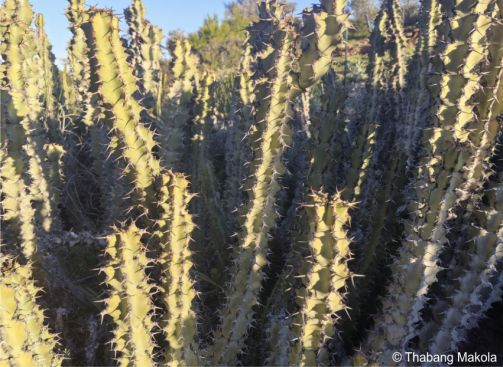
Description
Description
Euphorbia radyeri is a bushy succulent shrub that can grow about 1.5 m tall and 1-3 m wide. A slow-growing, long-lived and drought-tolerant plant that spreads fast by means of rhizomes. The noorsdoring has spiny branches that emerge from the stem base and are, on average, 50 mm thick, while new growth also develops from underground shoots. The branches are 4 to 6 angled, growing as long, narrow sections, strongly constricted into more or less spherical segments at intervals of 40-80 mm, usually with a striking blue-green colour, but also yellowish green. The paired spines are brownish in new growth and turn white or greyish when old, averaging between 2 and 15 mm long. Similarly, the lower part of the stems becomes pale grey and rough as the plant grows older. Tiny, green, simple, oval leaves, often smaller than 2 mm, are arranged opposite each other on the tips of new stem growth. The leaves are deciduous, normally appearing on young growth and soon falling off. Small clusters of yellow flowers, although not true flowers but floral structures termed cyathia, appear in large numbers at the tips of the branches, usually from early spring to summer. These cyathia are cup-shaped, 3.5–6 mm wide, bisexual (have both male and female organs), and often placed in a vertical cluster of three. The fruits are green trilocular capsules, 6-7 mm wide, turning pink-red when ripening, and can be seen in spring. Seeds are brown, on average 2 mm in size, and are located in sections of the capsules (three seeds per capsule).
The plants that make up the species Euphorbia radyeri were, until 2012, mistakenly identified as Euphorbia caerulescens. There were two very similar species of Euphorbia recognized from this region, the one named E. caerulescens and formally described and published by the British botanist Adrian Hardy Haworth in 1827 and the other E. ledienii, named and described by the German botanist Alwin Berger in 1903. Botanists struggled to differentiate between them on vegetative characteristics but noticed that some plants where rhizomatous and others were not, and differentiated them by placing the rhizomatous plants in E. caerulescens and non-rhizomatous plants in E. ledienii. In 2012, Peter Bruyns, realized that this conclusion was an error, because there is no mention of a rhizomatous habit in Haworth’s original description of E. caerulescens. And since there are no other significant differences between it and E. ledienii, he realized that they are the same species and placed E. ledienii in synonymy with E. caerulescens, both non-rhizomatous plants. Bruyns then placed the rhizomatous plants in a new species, E. radyeri, which differs from E. caerulescens (= E. ledienii) by having rhizomes, more bluish branches that are more deeply articulated into almost spherical segments compared to the more elongated, cylindrical segments of E. caerulescens. This correction has caused some confusion because the plants that were previously thought to be E. caerulescens are now E. radyeri, blue noors or soetnoors, and plants that were E. ledienii and are now E. caerulescens, green noors or suurnoors.
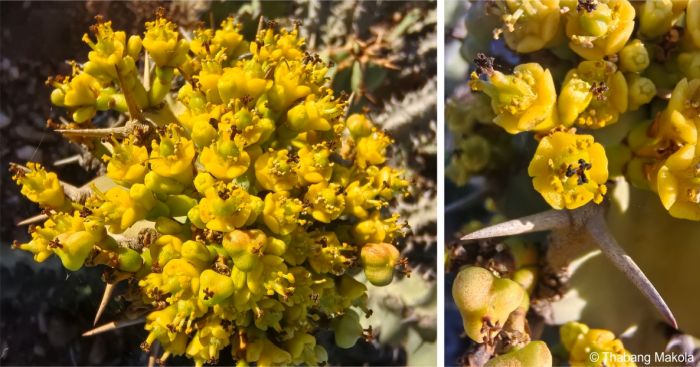
Conservation Status
Status
Euphorbia radyeri is currently assessed as Least Concern (LC) by the Red List of South African Plants. It is common and widespread and not in danger of extinction.
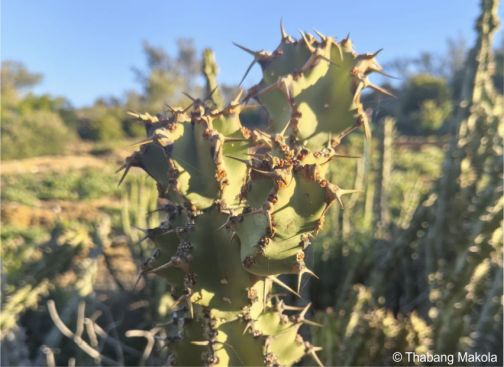
Distribution and habitat
Distribution description
The soetnoorsdoring is widely distributed in the Eastern Cape and Western Cape provinces of South Africa. The plant grows through the Little Karoo region, from Calitzdorp to Klipplaat. It is common around towns such as Jansenville, KwaNojoli (formerly Somerset East), Steytlerville, Kariega (Uitenhage), and Calitzdorp. The plant grows in dry places, especially on rocky slopes and flat stony ground. It is part of the Nama Karoo and Succulent Karoo biomes, which are extremely hot and dry.
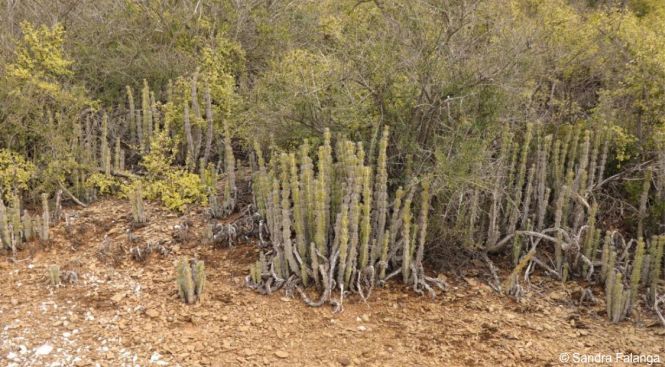
Derivation of name and historical aspects
History
The genus Euphorbia is named after Euphorbus, the Greek doctor to King Juba II of Mauretania. The name also means well fed from the Greek words eu-, meaning well and phorbe, pasture or feed. The species is named after the South African botanist Robert Allen Dyer (1900-1987), who collected the type specimen in 1930.
Euphorbia radyeri belongs to the family of Euphorbiaceae, a large and diverse plant group found worldwide with about 230 genera and over 2000 species that include succulent and non-succulent trees, shrubs, creepers, vines and cactus-like plants. The family is well known for its characteristic milky latex sap, which is poisonous in many species. Members of the genus Euphorbia are well known for their adaptability to arid conditions and distinctive stem and leaf morphology, which has made them highly valued in both horticulture and botanical research.
Ecology
Ecology
Euphorbia radyeri plays a key role in its natural environment. As a hardy xerophytic plant, it grows in dry, harsh areas where few plants can survive, helping to stabilize the soil and prevent soil erosion. It also supports the local food web by providing food and shelter for insects and birds, while its bright flowers attract pollinators such as beetles, butterflies, bees and ants. In this way, the plant acts both as a protector of the land and the supporter of life within the ecosystem. The noorsdoring protects itself from animals through both physical and chemical defenses. Its stiff spines deter large mammals from feeding on its stems, while its toxic milky latex irritates skin and mucous membranes, thus also discouraging predation. The latex also seals and protects wounds and reduces water loss, helping the plant conserve resources in arid environments. For seed dispersal, E. radyeri produces dry capsules that release seeds, often aided by ants or other small insects, to establish new seedlings beyond the parent plant.
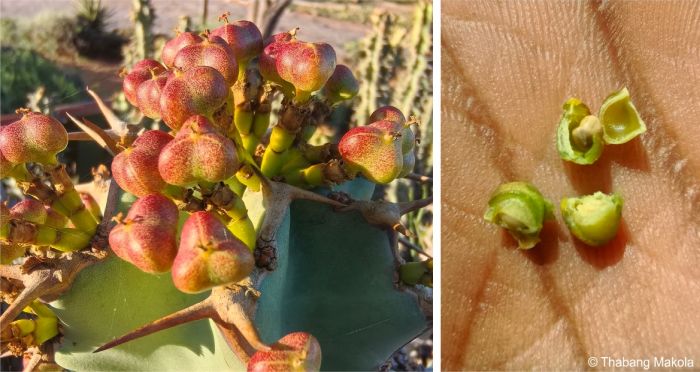
Uses
Use
Euphorbia radyeri makes an excellent specimen plant for water-wise gardens. Although its milky latex is toxic, the plant can be used as animal fodder for cattle when cut into sections and left to wilt for a few days, as this process removes the burning taste of latex, making it palatable for livestock, especially during drought when other food sources are limited.
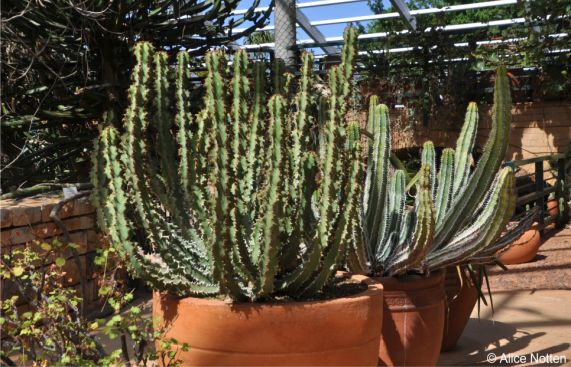
Growing Euphorbia radyeri
Grow
Euphorbia radyeri can be propagated either by seeds or cuttings, with cuttings being the preferred method.
At the Karoo Desert National Botanical Garden, E. radyeri has not yet been propagated by seeds, but other species of Euphorbia, such as E. triangularis and E. ingens are propagated using a specialized soil mixture known as the Karoo mix, which consists of 1 part red soil, 1 part river sand and 2 parts compost, carefully sieved to create a fine, uniform texture that promotes good drainage and aeration. This mix can be used for germinating E. radyeri seeds too. Fill sowing trays with a thin layer of fine bark at the base before adding the growth medium to prevent it from washing out, but also to encourage drainage. Scatter seeds on the growth medium surface, lightly pressing them into the soil to ensure good soil contact, and cover with a thin layer of finely sieved growth medium. Water the trays immediately and place them in a propagation house with bottom heat (where possible) to encourage germination. Ideally, water trays every two days to maintain consistent moisture, but do not overwater. As seedlings develop, watering should be reduced to once a week to prevent rot, since Euphorbia species are sensitive to overwatering. Once strong and healthy (7–8 cm), seedlings are transplanted into individual pots filled with the same growth medium and placed in full sun to harden off after three weeks from transplanting, helping them adapt to outdoor conditions and preparing them to thrive in their natural environment.
To propagate E. radyeri by cuttings, take stem cuttings in spring to early summer when the plant is in its active growth phase. Select a healthy, non-flowering stem and use sterilized pruning shears to make a clean cut just below a node. It is best to take a small, branched stem that has developed from the main stem and remove it from the base node. Since the plant exudes a toxic white latex sap, always wear gloves when handling the cuttings. Place the stem cuttings in a dry, shaded area for five to ten days to allow the wound to callus, reducing the risk of rotting. Once callused, plant cuttings on a raised plant bed filled with a washed coarse river sand. Alternatively, plant pots can be used as containers, using the same medium. Take care to provide balance or support for the cuttings to prevent them from falling over. A rooting hormone may be applied as well, although the cuttings are capable of rooting without it. Ensure that cuttings are placed in a bright area with indirect light and watered sparingly to keep the soil slightly moist but never waterlogged or completely dry. Roots develop within three to six weeks. Once the cuttings are well-rooted, transplant them into individual pots filled with the soil mix described above for seed sowing or any media suitable for succulents with good-drainage and begin the hardening-off process by slowly introducing the plant to full sun, which reflects its natural growing environment.
Euphorbia radyeri grows best in well-drained soil and full sun and should be protected from extreme winds and frost. It is particularly suited to sandy loam soils with rocky particles. A small amount of compost can be added since the plant does not need a lot of organic matter and can grow in poor soils. For successful growth, it is best to transplant young plants while they are still under 30 cm in height. Older plants tend to fall over, which may cause them to die. When planting, take care not to bury the stem, as this can lead to rotting. After planting, water regularly to keep the soil slightly moist until the roots are well established. Once the plant is settled, reduce watering and keep the plants dry during winter. This species also thrives in pots and garden settings. In pots, its bold blue-green columnar stems create a strong architectural statement, requiring minimal care while thriving on little water, and still need to be placed in full sun. In the garden, it is perfectly suited for rockeries and arid beds, where its sculptural form adds dramatic texture and contrast.
Just like other Euphorbia species, E. radyeri is prone to stem rot caused by overwatering and poor drainage, which should always be prevented, as this attracts pests and diseases. Common pests affecting E. radyeri include red spider mites, mealybugs, and white scale. When pests appear, they can be managed with insecticides or neem oil, while small infestations are best controlled by manual removal. To minimize pest problems, ensure that the plant is free from dead or damaged plant material.
References
- Barkhuizen, B.P. 1978. Succulents of southern Africa. Purnell and Sons Publishers, Cape Town.
- Bruyns, P.V. & Raimondo, D. 2014. Euphorbia radyeri Bruyns. National Assessment: Red List of South African Plants version 2024.1. https://redlist.sanbi.org/species.php?species=574-977.
- Bruyns, P.V. 2012. Nomenclature and typification of southern African species of Euphorbia. Bothalia 42(2): 217–245.
- Clarke, H. & Charters, M. 2016. The illustrated dictionary of southern African plant names. Flora & Fauna Publications Trust, Jacana, Johannesburg.
- Court, D. 2010. Succulent flora of southern Africa: Revised Edition. Random House Struik, Cape Town.
- Falanga, S. 2021-Oct. Observation of Euphorbia radyeri, Calitzdorp, WC. iNaturalist. Online. https://www.inaturalist.org/observations/99618905.
- Frandsen, R. 2017. Succulents of southern Africa. Honeyguide Publications, Somerset West.
- Goldblatt, P. & Manning, J. 2000. Cape Plants. A conspectus of the Cape flora of South Africa. Strelitzia 9. National Botanical Institute, Pretoria & Missouri Botanical Garden, Missouri.
- LLIFLE, The Encyclopedia of Succulents. Euphorbia coerulescens. https://www.llifle.net/Encyclopedia/SUCCULENTS/Family/Euphorbiaceae/21570/Euphorbia_coerulescens. Accessed 8/09/2025.
- Smith, G.F., Crouch, N.R. & Figueiredo, E. 2017. Field guide to succulents in southern Africa. Struik Nature, Cape Town.
- Smith, G.F. & Van Wyk, B-E. 2008. Garden succulents. Briza Publications, Pretoria.
- Stellenbosch University Botanical Garden, Garden Explorer. Euphorbia caerulescens. https://sun.gardenexplorer.org/taxon-2064.aspx. Accessed 27/08/2025.
- World Flora Online. Euphorbia ledienii A. Berger. https://list.worldfloraonline.org/browser.php?id=wfo-0000962987-2025-06. Accessed 07/09/2025.
Credits
Mapuleng Nkhobo & Thabang Makola
Karoo Desert National Botanical Garden
October 2025
Acknowledgements: taxonomic information provided by Alice Notten; image of Euphorbia radyeri in habitat by Sandra Falanga.
Plant Attributes:
Plant Type: Shrub, Succulent
SA Distribution: Eastern Cape, Western Cape
Soil type: Sandy, Loam
Flowering season: Spring, Early Summer
PH: Acid, Neutral
Flower colour: Yellow
Aspect: Full Sun
Gardening skill: Easy
Special Features:
Horticultural zones
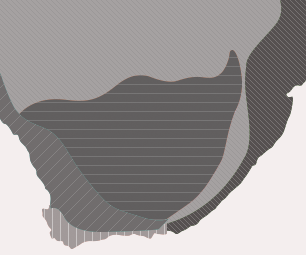









Rate this article
Article well written and informative
Rate this plant
Is this an interesting plant?
Login to add your Comment
Back to topNot registered yet? Click here to register.